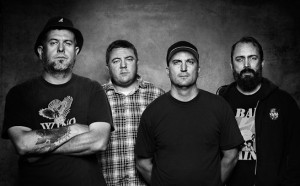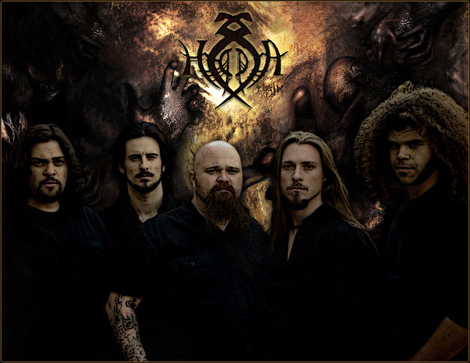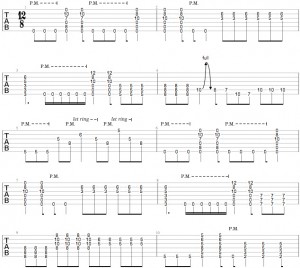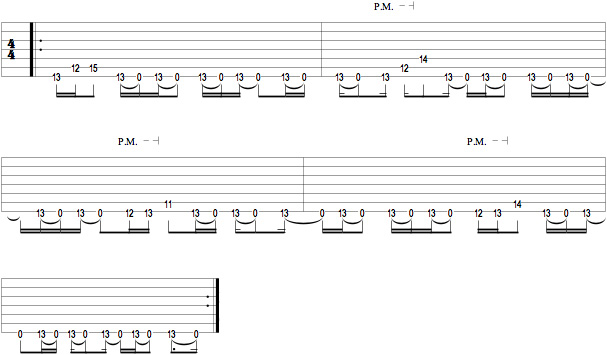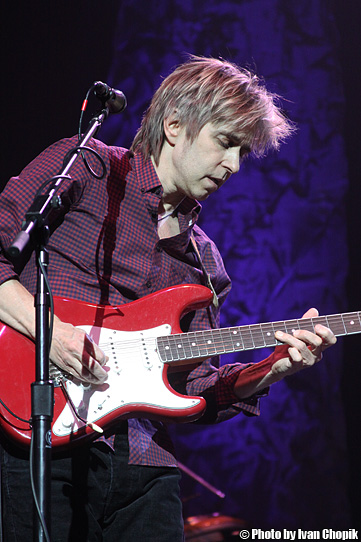 We last spoke with guitar luminary Eric Johnson during his debut with the Experience Hendrix tour in 2008. Two years later, following his third appearance on the star-studded celebration of Jimi’s music, we had the opportunity to meet again to discuss his latest musical endeavors, including the release of his latest studio gem Up Close.
We last spoke with guitar luminary Eric Johnson during his debut with the Experience Hendrix tour in 2008. Two years later, following his third appearance on the star-studded celebration of Jimi’s music, we had the opportunity to meet again to discuss his latest musical endeavors, including the release of his latest studio gem Up Close.
Up Close is one of Eric’s finest musical voyages to date, showcasing fifteen tracks of gracefully-crafted composition, which is amplified by his rich sonic textures and vast range of influences. In typical EJ fashion, the record is as toneful as ever and bursting at the seams with inspired performances – including those of a number of special guests, who each add a new dimension to the album’s sound. I spoke with Eric following his performance at the Boston, Massachusetts stop of the 2010 Experience Hendrix tour:
IC: The last time we spoke was two years ago, when you did your first Experience Hendrix tour.
EJ: That’s right – the first time I’d ever done it. This is the third time I’ve done it. I’ve been enjoying it, it’s a nice opportunity. It’s music I’d play if I was at home anyhow, because I love it. I’m playing a couple of different tunes this time than last time, so it gives me an opportunity to gain some new insights into Jimi’s music.
IC: It’s cool that you went beyond the staples that everyone knows and really dug further into Jimi’s catalog.
EJ: I think that’s my deal for this tour. I try to pick some of the sideline stuff that I like, and that I want to turn people on to. A lot of people know it, but maybe some don’t. I was really interested to do ‘Burning Of The Midnight Lamp.’ It’s a song I’d never done before, but I was reading the lyrics, and the lyrics are so amazing. I thought: ‘It’d be neat to work up a verse of that.’ I’m also doing ‘Drifting’ on some of the shows, which is off of The Cry of Love. It’s a beautiful ballad – I’ve always enjoyed the song, and I’ve always thought: ‘Someday I’d like to do that song.’ So we worked it out.
IC: I think tonight’s show was the first time I’ve ever seen you with a Floyd Rose on a Strat.
EJ: It’s actually called a Super-Vee tremolo. I like it because it fits on a vintage Strat – you don’t have to change the guitar. But it’s the same principle as a locking tremolo. Some of the songs, like ‘House Burning Down,’ would be really difficult to do without it if you wanted to stay in tune, because you’ve got all of this crazy stuff, but then you’ve gotta be really in tune for these chord voicings.
That’s kind of why I put that on there – I was like: ‘I just don’t know how I’m gonna do this.’ I do ‘Love Or Confusion’ sometimes, and you can kind of just tune it up for the tremolo bar and it stays in tune. But ‘House Burning Down’ has got all of this stretching, then all of these chords and all of these dive bombs. I was like: ‘I’m going to have to get a locking tremolo to do that.’ [laughs]
IC: Do you have any kind of routine or ritual that you go through before shows to get yourself prepared?
EJ: I like to just play a little bit before I go onstage, and the more you keep yourself in an advisable frame of mind for life, the more you’re going to be available to play a better show. If I’m coming from a heartful, soulful place, I’m going to play a better show. Even if one note doesn’t change from the night before, the audience is going to dig it a lot more. I think what’s up for me is just trying to get more in that pocket, that soulful zone.
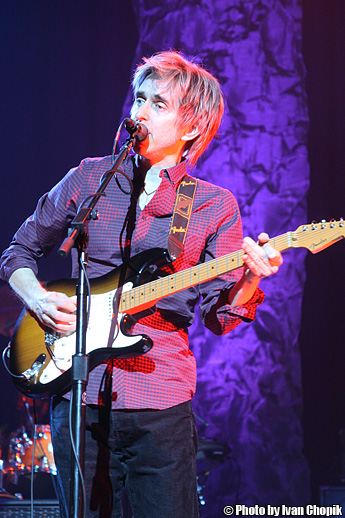
I like to just play a little bit so I’ve got it under my fingers, and then just go out and try to connect with the music and the people. I’ve spent enough time playing shows where I don’t connect, where I’m staring at the pedalboard or I’m thinking about my second Celestion on the top cabinet. At the end of the day, at some point you want to let all that go and start trying to connect.
I think it’s like learning to ride a bicycle – you wobble a lot or you use training wheels, and eventually you get to where you can ride it. I think that whatever you practice you get better at, and what I’d like to practice is that connection, because it’s a profound difference in the music you make and the way the audience appreciates it. So those are the kind of things I like to try to put into the recipe before I go out and play.
IC: I feel like that attitude has been something that you’ve been leaning towards over the past few years.
EJ: I got what I would call constructive criticism on the way that I make music. When you make records, if you belabor over them, and you get them to where everything is just perfect, it’s almost like you’ve put a governor on the flames. You get it down, and as you look at it, it looks like all the pieces are in the right order and you can put it on the mantle and its fine.
I think that I realized that the opportunity is there to start walking in a little different direction, where it’s like: ‘What if? What else can happen if you let go of some of that myopic perspective?’ – that’s what it really is. You might not think it is, but then all of a sudden you take that off and go: ‘Well, nobody can see 360 degrees.’ The only way you can widen your degree pattern is to realize that your degree pattern is not that wide.
Once you realize that, there’s a release of potential, and opportunity and possibility. That’s what I’m interested in now. I don’t know where it’ll lead, but I want to start using that as a mantra more, because I think it’ll make better music, and more valid music for the listener, as well as me and my enjoyment out of it. So I am moving that way. It’s taken me a while – I’m probably late to the party, but better late than never. [laughs] The party ain’t over yet, so it’s cool.
IC: Let’s talk about Up Close. Would you say that the approach you just described plays into the title of the album?
EJ: Yeah, that record started as business as usual, but I quickly just said: ‘You know what? I gotta switch.’ It kind of switched gears, and to me it’s like chapter one of trying to go more that way and think about that kind of vibe. As soon as I started thinking that way, and letting that be part of the recipe, immediately I started seeing different results. They might not have been night-and-day results, but they were enough to where they validated that that’s a good way to go. I think it’s a step towards where I want to keep going from now on.
IC: Up Close is your first studio record to feature a number of outside collaborations. At what point did you open yourself up to the possibility of bringing in guest artists?
EJ: I don’t think you’re defined… I don’t have to look at a permanent definition of me from just one snapshot in the second, that will be in the past a second later. If I have a song that I don’t think I’m singing the way I think would really pull it off, or if I think somebody plays something that would add to it, why not see what happens with that?

Because there’s always another song to write, there’s always more to do. If you think that second is all you’ve got, like: ‘This is that song I sung!’ that lends its way towards me wanting to just play it over and over and over, and do 50,000 different leads on it – ‘I’ve gotta do this, I’ve gotta do that.’
It’s just a song in a process of 80 or 100 songs or whatever. In that particular moment, it’s what seems to be a more natural flow. There were a couple of songs that I had sung, and they worked, but to me they weren’t emotionally selling it the way I wanted to.
So I brought Malford [Milligan] in to sing one, and then Jonny [Lang] sang one, and I thought: ‘Yeah, this is working better.’ It was nice, you add energy, too – people playing off of each other adding energy.
IC: ‘Gem’ has an amazing intro with all of these layered clean guitars. Can you tell us how that part came together?
EJ: That was kind of an improvised thing where it ended up being, I think, 16 guitars playing counterpoint. I’d start with one track, and then I’d put that down and go: ‘Oh, that reminds me. I could play this to it.’ So I’d play this to it and that to it, and all of a sudden I had a quartet that was doing a thing, and I thought: ‘What if I did something that was a contrapuntal thing.’
Sometimes stuff turns out interesting if I don’t really sweat step number ten or fifteen, if I just try to get step one – and that leads me to step two, which leads to step three. That’s where that intro came from. There wasn’t even an intro to the song, and I just went: ‘You know what?’ After I completely finished the song, we backed up and put a click track in the start, just so I had something to play to. I said: ‘Why don’t I just try to make up an intro, and see what happens.’
Richard Mullen mixed three songs on the record before he got ill. He’s better now, but he wasn’t able to finish the last part of my record. That was just a ten-minute rough mix of that song, and I actually used his rough mix of that whole song. It was one night before I was going home – I said: ‘Richard, will you run me a rough of ‘Gem’?’ He went: [imitates speedy mixing moves] ‘Okay, here you go.’ That’s the one I used on the record.
IC: I noticed this record was distributed by EMI, but released on Vortexan Records. Is that your own label?
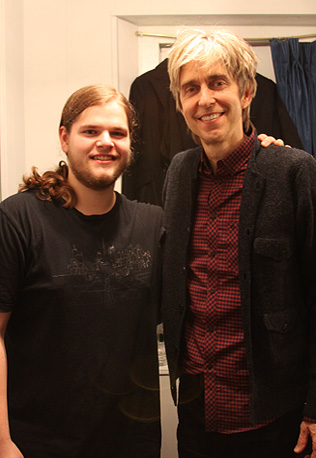
Eric Johnson and Ivan Chopik
EJ: It is. It’s a label I actually put together just for the Souvenir demo record that I did on the website, so we just kept it active. I think nowadays the record business is in such a state of flux, you can pick anything from doing the record totally yourself to doing it where you give everything away, and you can kind of decide. I knew I wanted to retain some of the rights as far as my music, but I also wanted to get on with a machinery that would help do something. So we just picked a negotiable line, where we gave away whatever to get some support and distribution.
IC: With all of the collaborations you’ve opened yourself up to between the Experience Hendrix tour and Up Close, do you anticipate expanding on this approach with future releases – either through a collaborative record, or even a band?
EJ: Absolutely, that could happen. I’d love to do some more collaboration stuff. We’re doing this acoustic tour as well, with Andy McKee and Peppino D’Agostino, which has been a lot of fun. We’ve got another leg to do in January. I definitely want to keep that going, and maybe let that be part of any solo record I do, as well – and as far as putting a band together, just figuring out what would be an interesting way to do that.
I think it’s interesting the way that Jeff Beck surrounds himself with these consummate bands. Above and beyond the fact that it’s great business sense, it’s great musical sense. He’s got this thing going on that’s really pushing everybody, and it’s nice. We’ll see what happens.
IC: As 2010 is wrapping up, can you give us a little insight into what you have in store for everyone this coming year?
EJ: Up Close will be out on December 7th, and I want to do this acoustic tour in January. I have three songs – I want to do a solo acoustic record, and I have three songs already cut. I want to try to do another seven or eight, and I’m hoping to put out the record next year. I actually have a bunch of new electric tunes I want to try, and maybe look at who I’m go to play with. I’m not sure what I’m gonna do. I might call Stevie Wonder and see if he’ll play with me – see if I can go play with him for free. [laughs]






